Industrial Temperature Control Equipment
Definition of industrial temperature control equipment
Industrial temperature control equipment is a temperature control system that can automatically regulate the industrial production process. It monitors the temperature in real time through the sensor and transmits the temperature signal to the controller. The controller compares and calculates according to the preset temperature range, and then controls the heating or cooling equipment through the actuator to keep the temperature within the preset range.
The principle of industrial temperature control equipment
industrial temperature control equipment is used to measure, monitor and control temperature. It consists of several components including sensors, controllers, actuators and displays. The sensor is used to measure the ambient temperature and transmit the data to the controller. The controller is a central processor responsible for receiving and processing the data provided by the sensor, and making judgments and processing according to the preset temperature range. The actuator adjusts the temperature according to the controller’s instructions to keep it within the preset range. Finally, the display is used to show real-time conditions of the ambient temperature and parameters set by the controller.
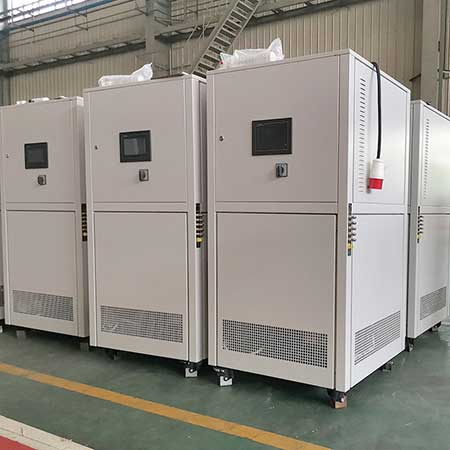
Features and advantages of industrial temperature control equipment
1. Intelligentization: With the development of artificial intelligence technology, industrial temperature control systems will become more intelligent. It can automatically adjust temperature control parameters and improve control accuracy and stability by learning and analyzing a large amount of data.
2. Energy saving and environmental protection: Industrial temperature control systems will pay more attention to energy saving and environmental protection. It can reduce energy consumption and environmental pollution by optimizing control strategies and using efficient heating or cooling equipment.
3. Multi-parameter control: Industrial temperature control systems will not only be limited to single temperature control, but will also consider the control of other parameters, such as humidity, pressure, etc. This will better meet the needs of different industries.
4. Remote monitoring: With the development of Internet technology, industrial temperature control systems will realize remote monitoring. Production personnel can remotely monitor and adjust the temperature through mobile phones or computers, improving production efficiency and convenience.
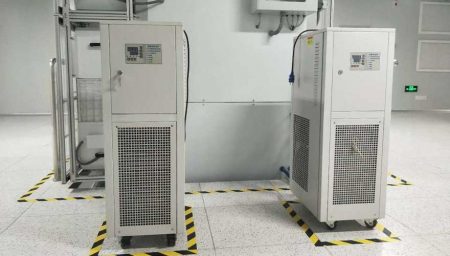
Application fields of industrial temperature control equipment
1. Petrochemical industry: In oil refining and chemical production, industrial temperature control systems can stabilize the temperature of reactors, distillation towers and other equipment to ensure the smooth progress of the production process.
2. Electronic manufacturing industry: In the manufacturing process of semiconductors and electronic components, industrial temperature control systems can control the temperature of equipment to ensure product quality and performance.
3. Food processing industry: During food heating, baking, freezing and other processes, industrial temperature control systems can control the temperature of food to ensure the taste and quality of food.
4. Pharmaceutical industry: During the production and storage of drugs, industrial temperature control systems can control the temperature of drugs to ensure the effectiveness and stability of the drugs.
5. Agriculture: Temperature control systems are usually used in greenhouses. For example, the temperature in the greenhouse needs to be strictly controlled in winter to ensure the growth of crops. The temperature control system can realize constant temperature or variable temperature control to adapt to the growth needs of different types of crops.
6. Automobile manufacturing industry: Temperature control systems are often used in manufacturing industries, especially in high-precision manufacturing. For example, in automotive engine manufacturing, engine parts require precise temperature control to ensure part quality and reduce work time. The temperature control system can monitor and control the temperature of machine parts to ensure the stability of the production environment and improve production efficiency.

The future development trend of industrial temperature control equipment
With the continuous development of technology, there will be more innovations and improvements in temperature control systems in the future. The following are several future development trends:
1. Application of cloud technology and Internet of Things
By using cloud technology and the Internet of Things, temperature control systems can be better remotely monitored and controlled. Technological developments will increase the scalability and customizability of temperature control systems.
2. Application of AI technology
AI technology has become a hot topic in many industries. Applying AI technology to temperature control systems can help improve control accuracy and enable intelligent monitoring and control.
3. Application of new materials
The development of new materials will make controllers lighter and more powerful. New materials can also make sensors more sensitive and have higher control accuracy.
Ofrecemos diseño y fabricación de sistemas completos de control de temperatura. Desde modelos estándar hasta productos personalizados completos de hasta 900 toneladas. Nos especializamos en el servicio al cliente y nos dedicamos a ayudar a cada cliente a tener el sistema de control de temperatura óptimo para su necesidad específica.
Ofrecemos soluciones personalizadas no estándar. Disponemos tanto de enfriadoras individuales como de unidades combinadas de refrigeración y calefacción.
Correo electrónico: info@lneya.com WeChat ID: +8615251628237 WhatsApp: +86 17851209193

Sistemas de refrigeración y calefacción (serie SUNDI)
Rango de control de temperatura: -120°C a +350°C
termostato de refrigeración y calefacción, ampliamente utilizado en diversas industrias.
| Temperatura | Serie -10 ~ +150°C | Serie -25 ~ +200°C | Serie -25 ~ +300°C | Serie -45 ~ +250°C | Serie -45 ~ +300°C | Serie -60 ~ +250°C | Serie -60 ~ +300°C | Serie -70 ~ +250°C | Serie -80 ~ +250°C | Serie -90 ~ +250°C | Serie -100 ~ +100°C | ||
| Capacidad de refrigeración | 1,5 ~ 15 kW | 1 ~ 200 kW | 1 ~ 200 kW | 0,45 ~ 200 kW | 0,9 ~ 25 kW | 0,25 ~ 60 kW | 0,75 ~ 25 kW | 0,4 ~ 15 kW | 0,3 ~ 80 kW | 0,2 ~ 80 kW | 0,45 ~ 80 kW | ||
| Nota: Se puede personalizar cualquier rango de temperatura de -150℃ ~ +350℃ y cualquier capacidad de refrigeración. | |||||||||||||
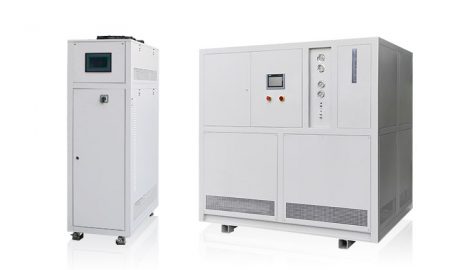
Sistemas de refrigeración y calefacción (serie WTD)
(Microcanales / reactores tubulares especializados)
Rango de control de temperatura: de -70°C a +300°C
Diseño especializado para microcanal (pequeña capacidad de retención de líquido, gran capacidad de intercambio de calor, sistema de circulación de alta caída de presión)
| Temperatura | -70°C ~ +300°C | -45°C ~ +250°C | -70°C ~ +200°C | ||||||
| Capacidad de refrigeración | 1,1 ~ 7,5 kW | 1,5 ~ 5,5 kW | 11 ~ 50kW | ||||||
| Nota: Se puede personalizar cualquier rango de temperatura de -150℃ ~ +350℃ y cualquier capacidad de refrigeración. | |||||||||

Circuladores de refrigeración y calefacción
Rango de control de temperatura: -45°C a +250°C
| Temperatura | Serie -25°C ~ +200°C | Serie -45°C ~ +250°C | |||||||
| Capacidad de refrigeración | 1 ~ 15 kW | 0,25 ~ 15 kW | |||||||
| Nota: Se puede personalizar cualquier rango de temperatura de -150℃ ~ +350℃ y cualquier capacidad de refrigeración. | |||||||||
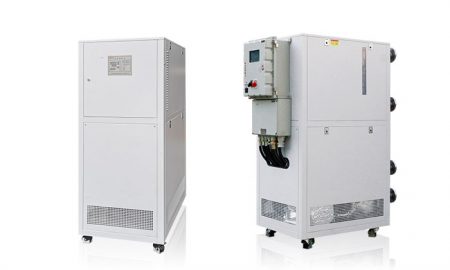
Termostatos de circulación
Rango de control de temperatura: +50°C a +300°C
Nota: La serie UC puede controlar la temperatura del medio de transferencia de calor. La serie UST no solo puede controlar la temperatura del medio de transferencia de calor, sino también la temperatura del material de reacción.
| Temperatura | +50°C ~ +170°C (serie UC) | +50°C ~ +300°C (serie UC) | +50°C ~ +300°C (serie UST) | ||||||
| Capacidad de calefacción | 5,5 ~ 15 kW | 3,5 ~ 130 kW | 3,5 ~ 95 kW | ||||||
| Nota: Se puede personalizar cualquier rango de temperatura de -150℃ ~ +350℃ y cualquier capacidad de refrigeración. | |||||||||
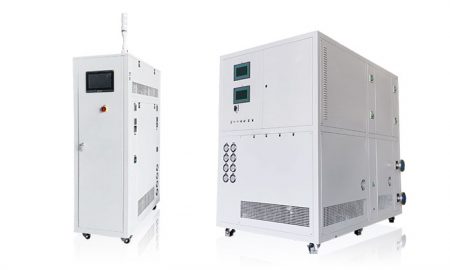
Serie TES
Rango de control de temperatura: -85°C a +250°C
| Temperatura | Serie -45°C ~ +250°C | Serie -85°C ~ +200°C | Serie -60°C ~ +200°C | ||||||
| Capacidad de refrigeración | 0,3 ~ 25 kW | 0,25 ~ 25 kW | 3 ~ 60kW | ||||||
| Nota: Se puede personalizar cualquier rango de temperatura de -150℃ ~ +350℃ y cualquier capacidad de refrigeración. | |||||||||

Serie LTS (Líquido fluorado)
Temperature Control Range: -80°C to +80°C
| Temperatura | Serie -20°C ~ +80°C | Serie -45°C ~ +80°C | Serie -60°C ~ +80°C | Serie -80°C ~ +80°C | |||||
| Control de caudal | 7 ~ 45 L/min | 7 ~ 45 L/min | 7 ~ 45 L/min | 7 ~ 45 L/min | |||||
| Nota: Se puede personalizar cualquier rango de temperatura de -150℃ ~ +350℃ y cualquier capacidad de refrigeración. | |||||||||
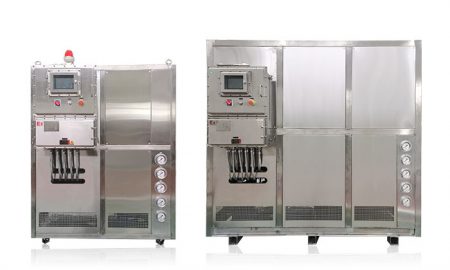
TCU Sistema de control de temperatura multirreactores
Rango de control de temperatura: -120°C a +250°C
| Temperatura | Serie -45°C ~ +250°C | Serie -120°C ~ +250°C | Sistema de control de temperatura personalizado | RT+10°C ~ +135°C | |||||
| Capacidad de calefacción | 25 ~ 80 kW | 25 ~ 80 kW | A medida | 25 ~ 300 kW | |||||
| Nota: Se puede personalizar cualquier rango de temperatura de -150℃ ~ +350℃ y cualquier capacidad de refrigeración. | |||||||||

Enfriadoras de recirculación / Criotermostatos
El enfriador puede utilizarse ampliamente en diversas industrias y laboratorios, y admite diseños personalizados.
| Temperatura | Serie -25°C ~ +30°C | Serie -45°C ~ +30°C | Serie -60°C ~ -20°C | Serie -80°C ~ -20°C | Serie -120°C ~ -70°C | ||||
| Capacidad de refrigeración | 0,8 ~ 30 kW | 0,75 ~ 12 kW | 0,4 ~ 6kW | 0,2 ~ 6kW | 0,3 ~ 5kW | ||||
| Nota: Se puede personalizar cualquier rango de temperatura de -150℃ ~ +350℃ y cualquier capacidad de refrigeración. | |||||||||
 Enfriadoras de agua / Enfriadoras pequeñas
Enfriadoras de agua / Enfriadoras pequeñas
El enfriador puede utilizarse ampliamente en diversas industrias y laboratorios, y admite diseños personalizados.
| Temperatura | -18°C ~ +30°C | Serie +5°C ~ +35°C | |||||||
| Capacidad de refrigeración | 0,35 ~ 0,9 kW | 1,8 ~ 50 kW | |||||||
| Nota: Se puede personalizar cualquier rango de temperatura de -150℃ ~ +350℃ y cualquier capacidad de refrigeración. | |||||||||

Refrigeradores de baja temperatura
Estamos especializados en la producción de refrigeradores de baja temperatura con un rango de control de temperatura de hasta -150°C, que pueden satisfacer las necesidades de refrigeración de diferentes industrias.
| Temperatura | Serie -25°C ~ -5°C | Serie -45°C ~ -10°C | Serie -60°C ~ -10°C | Serie -80°C ~ -30°C | Serie -110°C ~ -50°C | Serie -150°C ~ -110°C | |||
| Capacidad de refrigeración | 12 ~ 360 kW | 6 ~ 180 kW | 6 ~ 180 kW | 4 ~ 180kW | 2 ~ 120kW | 2,5 ~ 11 kW | |||
| Nota: Se puede personalizar cualquier rango de temperatura de -150℃ ~ +350℃ y cualquier capacidad de refrigeración. | |||||||||
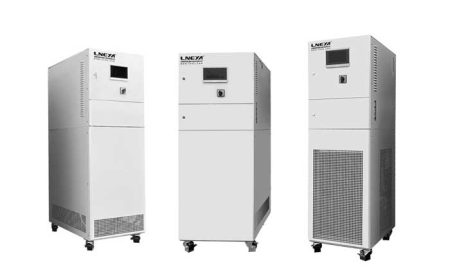
Refrigeradores de alta temperatura
El enfriador puede utilizarse ampliamente en diversas industrias y laboratorios, y admite diseños personalizados.
| Temperatura | +5°C ~ +40°C | -25°C ~ +40°C | -45°C ~ +40°C | -80°C ~ +80°C | -100°C ~ +80°C | ||||
| Capacidad de refrigeración | 6 ~ 40kW | 2 ~ 15kW | 1 ~ 8kW | 0,6 ~ 3 kW | 1,5 ~ 3 kW | ||||
| Nota: Se puede personalizar cualquier rango de temperatura de -150℃ ~ +350℃ y cualquier capacidad de refrigeración. | |||||||||
 LNEYA
LNEYA
 简体中文
简体中文


















































































